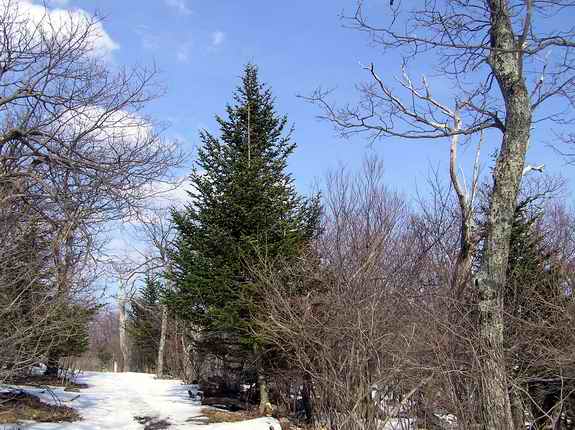|
Return to Hiker's Notebook Homepage
Common Name: Balsam Fir, Canada balsam, Eastern Fir, Balm of Gilead Fir. American Silver Fir, Balsam Spruce, Bracted Balsam Fir. Scientific Name: Abies balsamea - The generic name Abies is the Latin word for the silver fir tree, a native to the mountainous areas of Europe, the basis for the fir tree genus taxonomy (flattened single needles with erect cones); the species name is from the Latin balsamum, the "sweet-smelling gum of the balsam-tree."
The name Balsam Fir is a misnomer, as the resinous substance produced by the tree is not a balsam but an oleoresin. Balsam is a general term given to any oily or gummy aromatic resins obtained from a variety of plants that contain either benzoic and/or cinnamic acid. Balsam originated in the Mediterranean region as a secretion of Commiphora Opobalsamum (commonly called the Balsam-tree or Balm of Gilead tree) and was used as a healing and soothing ointment. The aromatic and oleaginous properties of the oleoresin of the Balsam Fir were reminiscent of balsam and engendered the name.
Balsam and its etymological derivative balm are attributed to the Hebrew bot smin meaning "chief of oils" or alternatively basam, balm, or besem, sweet smelling. The biblical "balm of Gilead" appears only in the book of Jeremiah who asks "Is there no balm in Gilead?" The Jewish historian Josephus relates that the Balsam-tree was brought from Arabia to Judea by the Queen of Sheba as a present for King Solomon. According to this account, it was thereafter cultivated on Mount Gilead for its secreted resins, and therefore came to be known as the balm of Gilead.
The effluent derived from the Balsam Fir is known as Canada balsam, a term that is used in some locales as the name for the tree. It is sometimes referred to as turpentine, a volatile essential oil originally derived from the terebinth tree (Pistacia terebinthus). However, Canada balsam is not fully volatile turpentine as it contains about 70 percent resin with only 30 percent volatile oils. It is an oleoresin and has been used in a wide variety of medicinal and other product applications in North America for centuries.
The Balsam Fir was very important to the Indians as both a food and as a medicine. The inner bark was peeled away and made into bread; the outer bark chewed for its sweet flavor and mucilaginous texture. The Mohawk name for one of the New England tribes was atiru: taks which meant tree-eater, presumably referring to their consumption of the prevalent Balsam Fir; the tribal name was anglicized as the etymological source for the Adirondack Mountains.
Medicinal uses of the Balsam Fir by the Indians were diverse, varying according to the custom of the tribe. The Iroquois made a warm liquid from the sap that they used in the treatment of gonorrhea; a decoction of roots and branches was used to create sweat baths to alleviate pain from rheumatism and parturition. The Ojibwe, Micmac and Potawatomi used the gum as a salve to treat wounds and swallowed fresh balsam gum to treat colds. The Chippewa melted the gum on a warm stone, inhaling the fumes to treat headaches.
The potential for the exploitation of the Balsam Fir was not lost on the early colonists. According to an article on Canada balsam that appeared in the American Journal of Pharmacy in 1881, Marc Lescarbot visited Nouvelle-France in the early 17th Century and "noted that the pines of Canada are very rich in gum � as fine as that of Venice, and quite excellent in pharmacy." He furnished some to churches in Paris where it was used as incense for religious ceremonies.
Canada balsam was initially assimilated into European society as a medicinal and as a salve, its ubiquity leading through trial and error to another highly specialized application. The oleoresin of the Balsam Fir has an unusually high index of refraction compared to other resins and comparable to that of glass. This, combined with its adhesive properties, made it ideal for the cementing of optical glass. It was the primary bonding agent for complex optical instruments until the late 20th Century when it was supplanted by synthetic resins that are not subject to long-term aging effects such as crazing. It is still used a medium for mounting microscopic specimens on glass slides.
The Balsam Fir is the only fir tree that is native to the Northeast. It grows best in cool areas with a mean temperature range of 2 to 4 degrees Centigrade and a mean precipitation of 39 to 140 centimeters a year. In the southern Appalachians, it is found above 4,000 feet, such as at Hawksbill Mountain in Shenandoah National Park. Balsam Fir is closely related to the Fraser Fir (A. fraseri), which is found at higher elevations further south, primarily in the Great Smoky Mountains. Due to their similarity, it has been suggested that they be combined into one species as A. balsamea var. balsamea and A. balsamea var. fraseri. A possible hybrid, A. intermedia, has been reported.
|
